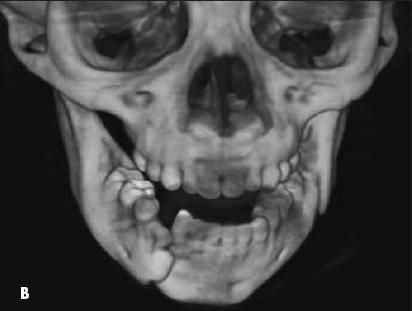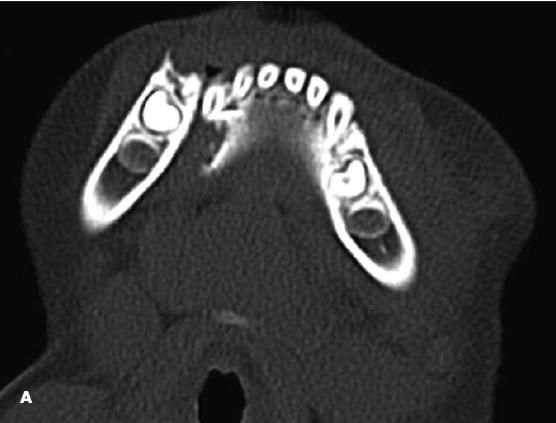Mandible Fracture After a Motor Vehicle Accident
A 4-year-old girl was brought to the emergency department after she sustained an injury to her jaw in a car accident. She had been restrained in the rear passenger seat with a seat belt. She had not lost consciousness and was not ejected from the vehicle.
A 4-year-old girl was brought to the emergency department after she sustained an injury to her jaw in a car accident. She had been restrained in the rear passenger seat with a seat belt. She had not lost consciousness and was not ejected from the vehicle.

Vital signs were stable. Her weight was 23 kg; height was 117 cm. She had swelling and ecchymosis of the left lower jaw and dried blood around her lips. Intraorally, a few blood clots were present on the gum line with an obvious step off anteriorly.
Axial (A) and 3-dimensional (B) CT scans revealed a left mandibular angle/body fracture that was displaced and open and a right mandibular body fracture between the deciduous canine tooth and first molar that was also open and widely displaced. The patient underwent open reduction with internal fixation. Recovery was uneventful.
Fractures of the mandible in children are complicated by the developing anatomy, particularly the presence of tooth buds and the eruption of deciduous and permanent teeth.1 Because of the presence of tooth buds and crypts, the fractures are often long and irregular, running inferiorly and anteriorly. They are associated with many complications, including growth disturbances with facial asymmetry, maloccusion and poor mastication, osteomyelitis, tooth bud damage, temporomandibular joint syndrome, salivary disorders, obstructive sleep apnea, and chronic pain.2,3

The type of treatment depends on the severity of the fracture and the age of the patient.4,5 Referral to an oral surgeon is required in most cases.
This child's fracture might have been prevented if she had been in a booster seat. The American Academy of Pediatrics recommends the use of a booster seat for older children until adult seat belts fit correctly- usually until the child is about 144.8 cm (57 in) tall and between 8 and 12 years of age.6 Discussing the use of booster seats for older children with parents and caregivers during regular well child care visits could help raise awareness.
References:
1.
McGuirt WF, Salisbury PL 3rd. Mandibular fractures. Their effect on growth and dentition.
Arch Otolaryngol Head Neck Surg.
1987;113:257-261.
2.
Rowe NL. Fractures of the jaws in children. J Oral Surg. 1969;27:497-507.
3.
Schweinfurth JM, Koltai PJ. Pediatric mandibular fractures.
Facial Plast Surg.
1998;14:31-44.
4.
Hardt N, Gottsauner A. The treatment of mandibular fractures in children.
J Craniomaxillofac Surg.
1993;21:214-219.
5.
Jamerson RE, White JA. Management of pediatric mandibular fractures.
J La State Med Soc.
1990;142:11-13.
6.
American Academy of Pediatrics. Car Safety Seats: A Guide for Families 2008.
http://www.aap.org/family/Carseatguide.htm#BoosterSeats
. Accessed November 11, 2008.